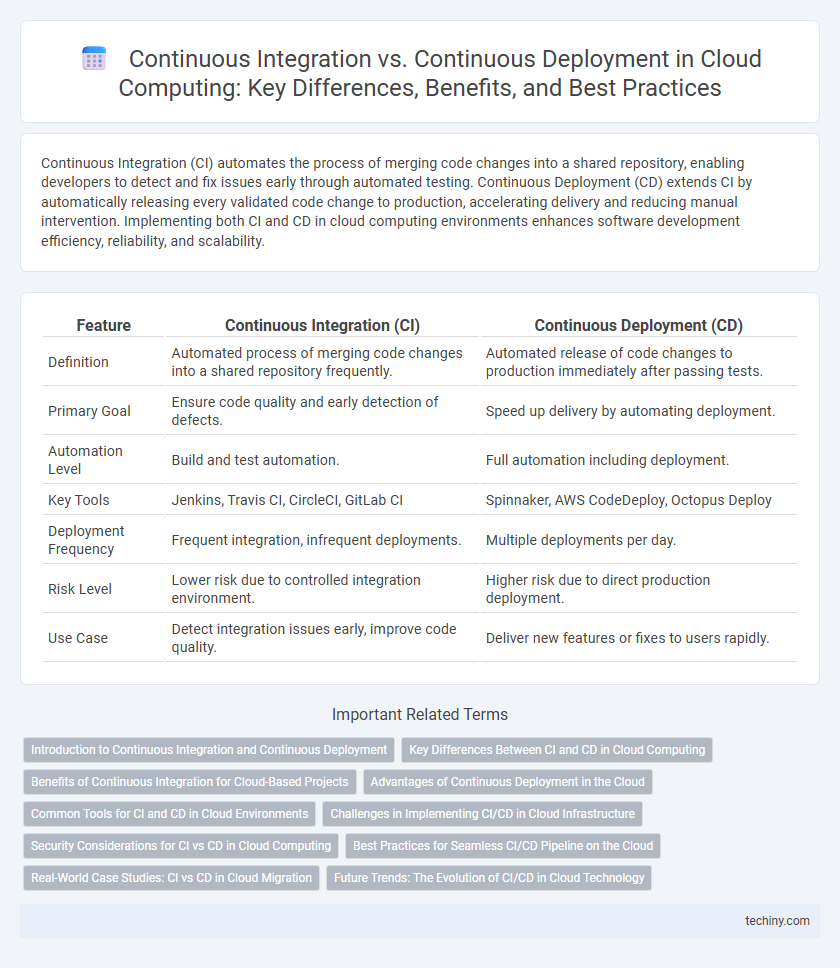Continuous Integration (CI) automates the process of merging code changes into a shared repository, enabling developers to detect and fix issues early through automated testing. Continuous Deployment (CD) extends CI by automatically releasing every validated code change to production, accelerating delivery and reducing manual intervention. Implementing both CI and CD in cloud computing environments enhances software development efficiency, reliability, and scalability.
Table of Comparison
| Feature | Continuous Integration (CI) | Continuous Deployment (CD) |
|---|---|---|
| Definition | Automated process of merging code changes into a shared repository frequently. | Automated release of code changes to production immediately after passing tests. |
| Primary Goal | Ensure code quality and early detection of defects. | Speed up delivery by automating deployment. |
| Automation Level | Build and test automation. | Full automation including deployment. |
| Key Tools | Jenkins, Travis CI, CircleCI, GitLab CI | Spinnaker, AWS CodeDeploy, Octopus Deploy |
| Deployment Frequency | Frequent integration, infrequent deployments. | Multiple deployments per day. |
| Risk Level | Lower risk due to controlled integration environment. | Higher risk due to direct production deployment. |
| Use Case | Detect integration issues early, improve code quality. | Deliver new features or fixes to users rapidly. |
Introduction to Continuous Integration and Continuous Deployment
Continuous Integration (CI) is a development practice where code changes are automatically tested and merged into a shared repository multiple times a day, ensuring early detection of defects and improving software quality. Continuous Deployment (CD) extends CI by automating the release of tested code to production environments, enabling faster and more reliable software delivery. Together, CI/CD pipelines enhance agility and efficiency in cloud-based application development and operations.
Key Differences Between CI and CD in Cloud Computing
Continuous Integration (CI) in cloud computing automates code integration and testing, ensuring that new code changes are regularly merged and validated in a shared repository. Continuous Deployment (CD) extends CI by automatically releasing tested code into production environments, enabling rapid delivery and frequent updates without manual intervention. The key differences lie in CI focusing on code integration and validation, while CD centers on automated delivery and deployment pipelines within cloud infrastructure.
Benefits of Continuous Integration for Cloud-Based Projects
Continuous Integration (CI) in cloud-based projects accelerates software delivery by automating code integration and testing, reducing integration conflicts and bugs early. It enhances collaboration among distributed teams by providing immediate feedback and ensuring code consistency across cloud environments. CI improves deployment reliability and accelerates innovation cycles, crucial for agile cloud-native development and scalable infrastructure management.
Advantages of Continuous Deployment in the Cloud
Continuous Deployment in the cloud accelerates software delivery by automating the release process, reducing human error and ensuring rapid feature availability to users. Cloud environments provide scalable infrastructure that supports seamless updates and rollback capabilities, enhancing system reliability and uptime. Leveraging Continuous Deployment in the cloud also fosters faster innovation cycles, as developers can immediately validate changes with real-time user feedback and performance metrics.
Common Tools for CI and CD in Cloud Environments
Jenkins, GitLab CI/CD, and CircleCI are widely used continuous integration (CI) tools in cloud environments, enabling automated testing and code integration. For continuous deployment (CD), tools like Spinnaker, Argo CD, and AWS CodeDeploy streamline release automation by managing application delivery across multiple cloud platforms. Kubernetes-native solutions such as Helm and Flux integrate with CI/CD pipelines to enhance deployment strategies and maintain infrastructure as code in cloud-native applications.
Challenges in Implementing CI/CD in Cloud Infrastructure
Implementing CI/CD in cloud infrastructure presents challenges such as managing environment inconsistencies across multiple cloud platforms, ensuring secure integration of automated pipelines, and handling scalability during peak workloads. Complexities in synchronizing continuous integration tools like Jenkins, GitLab CI, or CircleCI with cloud-native services often lead to configuration drift and deployment failures. Monitoring and maintaining compliance with security policies while automating deployment pipelines remains critical to avoiding vulnerabilities in dynamic cloud environments.
Security Considerations for CI vs CD in Cloud Computing
Continuous Integration (CI) emphasizes secure code integration by enforcing automated security testing and vulnerability scanning early in the development pipeline, reducing risks before deployment. Continuous Deployment (CD) requires robust runtime security controls, including automated rollback mechanisms and infrastructure-as-code policies to prevent unauthorized changes in the live cloud environment. Both CI and CD in cloud computing must incorporate identity and access management (IAM), encryption, and compliance auditing to maintain a secure and resilient delivery process.
Best Practices for Seamless CI/CD Pipeline on the Cloud
Implement automated testing and monitoring tools within the CI/CD pipeline to ensure rapid feedback and early detection of code issues in cloud environments. Use containerization technologies like Docker and orchestration platforms such as Kubernetes to maintain consistent deployment across multiple cloud instances. Implement version control, automated rollback mechanisms, and infrastructure as code (IaC) to enhance reliability and scalability in continuous integration and deployment on the cloud.
Real-World Case Studies: CI vs CD in Cloud Migration
Real-world case studies of cloud migration highlight that Continuous Integration (CI) streamlines code validation through automated testing, enabling teams to detect issues early in the cloud environment. Continuous Deployment (CD) accelerates the release process by automatically deploying validated code to production, reducing cloud migration downtime and minimizing manual errors. Organizations adopting CI/CD pipelines during cloud migration report improved deployment frequency and faster recovery times, demonstrating significant operational efficiency gains.
Future Trends: The Evolution of CI/CD in Cloud Technology
Future trends in CI/CD within cloud technology emphasize increased automation powered by AI and machine learning, enabling more intelligent test orchestration and faster feedback loops. Serverless architectures and microservices will drive the need for more granular deployment strategies, improving scalability and resilience. Integration of security practices directly into the CI/CD pipeline, known as DevSecOps, will become a standard to ensure continuous compliance and threat mitigation.
Continuous Integration vs Continuous Deployment Infographic

 techiny.com
techiny.com